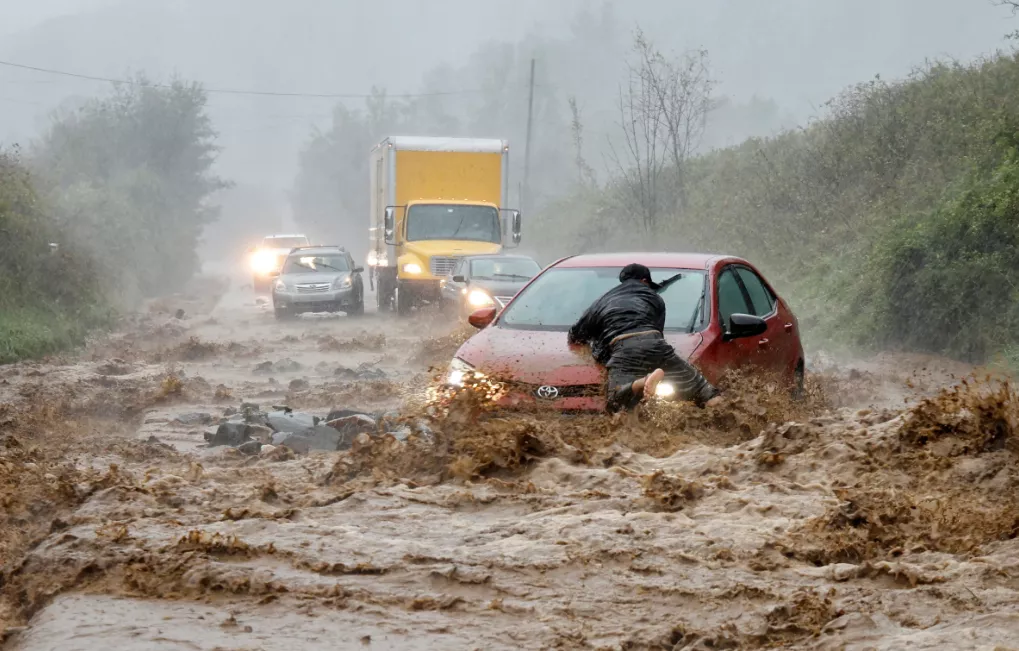Hurricane Helene has left a devastating trail across multiple southeastern states, killing at least 57 people and leaving nearly three million customers without power from Florida to Ohio as the storm continued to ravage the region on Saturday.
The powerful storm made landfall in Florida’s Big Bend area on Thursday night as a Category 4 hurricane, bringing sustained winds of 140 mph. Despite weakening to a post-tropical cyclone, Helene continued to cause “catastrophic, historic” flooding in the southern Appalachians by late Friday, according to the National Hurricane Center (NHC).
Forecasters expect the remnants of Helene to hover over the Tennessee Valley throughout Saturday and Sunday, with high wind warnings issued across parts of Tennessee and Ohio.
President Biden Pledges Support
President Biden expressed his condolences for the lives lost and the widespread devastation, stating, “The road to recovery will be long, but my Administration will be with you every step of the way. We’re not going to walk away. We’re not going to give up.”
By Saturday evening, over 2.98 million people across Florida, Georgia, North Carolina, South Carolina, Tennessee, and Virginia were without power, according to utility tracker Find Energy.
Death Toll Mounts Across States
Hurricane Helene has claimed lives across multiple states. In Georgia, 17 people lost their lives, including a first responder, according to a spokesperson for Governor Brian Kemp. South Carolina reported 21 deaths, including two firefighters and two residents killed by falling trees. In Florida, 11 people were confirmed dead, five of them in Pinellas County. Crews have conducted thousands of rescue missions across the state.
North Carolina also experienced significant loss, with seven deaths reported. One fatality occurred when a person was involved in a car accident on a flooded road, while another died after a tree fell on their house. Virginia’s Governor Glenn Youngkin confirmed one death in his state.
Storm Impact and Historic Context
Helene made landfall near Perry, Florida, at 11:10 p.m. EDT Thursday, marking it as the fourth hurricane to hit the Gulf Coast this year — a rare occurrence in U.S. history, meteorologist Stephanie Abrams of The Weather Channel reported.
This is the third major hurricane to strike Florida’s Big Bend region in the past 13 months. In 2023, Hurricane Idalia hit the same area as a Category 4 storm, generating record-breaking storm surges. The year before, Hurricane Debby also brought devastation to the region. Florida Governor Ron DeSantis said damage from Helene appears to exceed the combined destruction caused by Idalia and Debby.
“We have a lot of damage throughout the state, particularly along the west coast and the peninsula,” DeSantis said.
Federal Emergency Response
The Federal Emergency Management Agency (FEMA) has deployed more than 800 personnel to assist with the response efforts. FEMA Administrator Deanne Criswell traveled to Florida on Saturday to survey the damage. President Biden also issued emergency declarations for Florida, Georgia, Alabama, North Carolina, South Carolina, and Tennessee, freeing up federal resources for recovery efforts.
Communities Devastated
The storm wreaked havoc on towns and cities across the region. In Florida’s Taylor County, officials estimated that 90% of homes in the Keaton Beach area were destroyed. In Cedar Key, officials declared the area unsafe for residents and rescue workers due to ongoing hazards.
In Tennessee, severe flooding in East Tennessee forced evacuations in the city of Newport, where two dams were at risk of failure. Meanwhile, in Atlanta, residents faced their own struggles, with floodwaters inundating neighborhoods and leaving homes submerged.
In Valdosta, Georgia, entire communities were left under water, with over 115 structures severely damaged, Governor Kemp said. He described the devastation as looking like “a tornado or a bomb went off.”
Rescue Efforts Amid the Destruction
Heroic rescue efforts have taken place in various locations. In one dramatic operation, a U.S. Coast Guard crew saved a man and his dog stranded on a sailboat off Florida’s Sanibel Island. In other areas, residents like Annie Sloan sought refuge in shelters after losing their homes.
Access to Tampa’s barrier islands, which were heavily damaged, was restored on Saturday, but residents returned to communities with no power, water, and catastrophic flood damage.
Record-Breaking Warm Waters Fueled Helene’s Strength
Helene’s intensity was fueled by record-warm waters in the Gulf of Mexico. Brian McNoldy, a senior research associate at the University of Miami, noted that the ocean heat content in the Gulf is the highest on record, which significantly contributed to the storm’s rapid intensification. Sea surface temperatures in Helene’s path reached up to 89 degrees Fahrenheit — 2 to 4 degrees above average.
These record-breaking water temperatures have been linked to human-caused climate change, according to Climate Central. The North Atlantic Ocean has experienced unprecedented warmth in 2024, absorbing much of the excess heat generated by greenhouse gas emissions.
Conclusion
Helene, the eighth named storm of the 2024 Atlantic hurricane season, has left behind a path of destruction, with communities grappling with the loss of life, homes, and power. The storm’s devastating effects will be felt for months as recovery efforts continue across the Southeast.
Related topics:
- Two Dead as Hurricane John Hits Mexico, Prompting Flash Flood Warnings
- Daulton Varsho Transferred to 60-Day Injured List Following Shoulder Surgery
- Motorcycle Crash in Simi Valley Results in Serious Injuries and Road Closure

